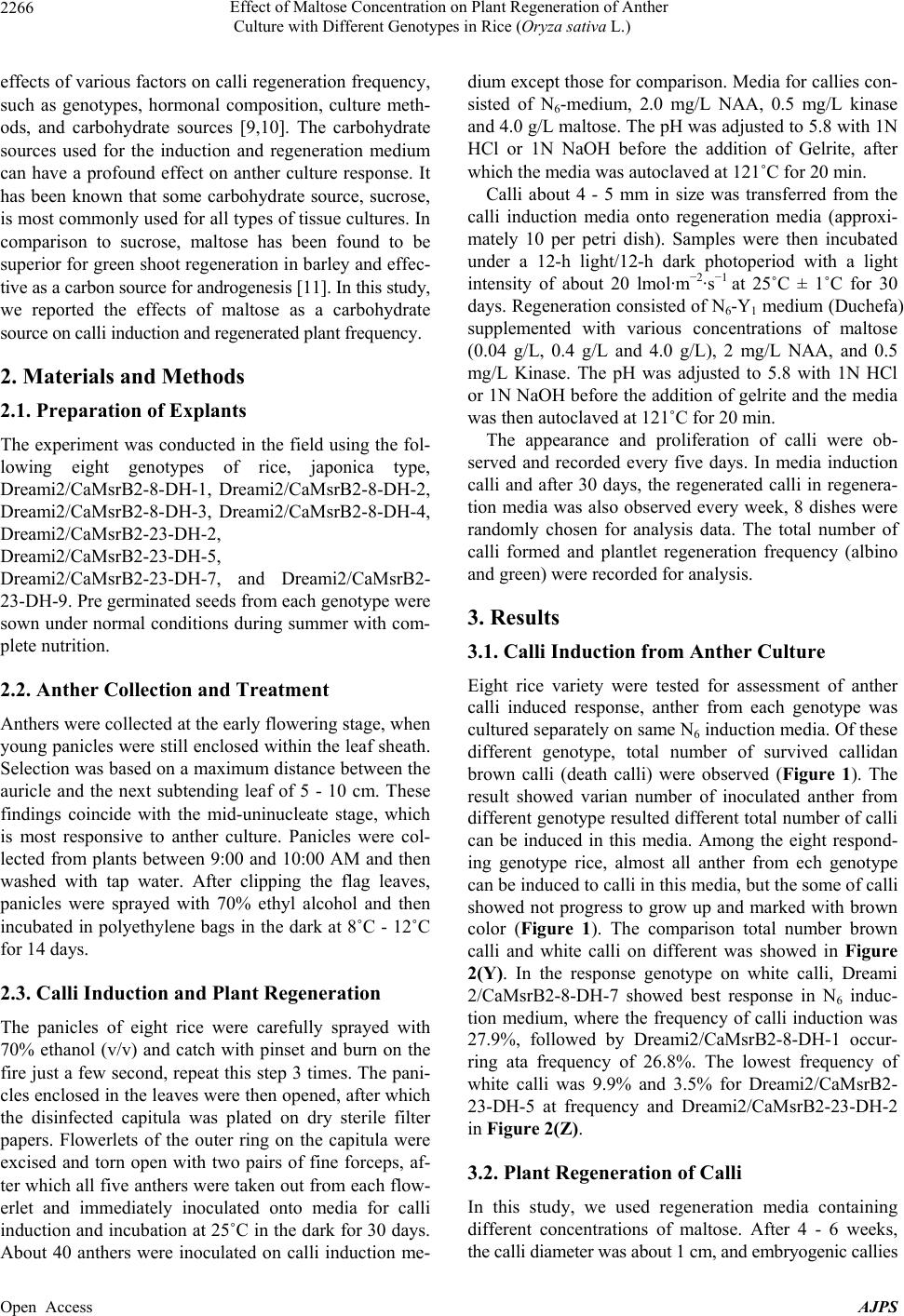
Effect of Maltose Concentration on Plant Regeneration of Anther
Culture with Different Genotypes in Rice (Oryza sativa L.)
2266
effects of various factors on calli regeneration frequency,
such as genotypes, hormonal composition, culture meth-
ods, and carbohydrate sources [9,10]. The carbohydrate
sources used for the induction and regeneration medium
can have a profound effect on anther culture response. It
has been known that some carbohydrate source, sucrose,
is most commonly used for all types of tissue cultures. In
comparison to sucrose, maltose has been found to be
superior for green shoot regeneration in barley and effec-
tive as a carbon source for androgenesis [11]. In this study,
we reported the effects of maltose as a carbohydrate
source on calli induction and regenerated plant frequency.
2. Materials and Methods
2.1. Preparation of Explants
The experiment was conducted in the field using the fol-
lowing eight genotypes of rice, japonica type,
Dreami2/CaMsrB2-8-DH-1, Dreami2/CaMsrB2-8-DH-2,
Dreami2/CaMsrB2-8-DH-3, Dreami2/CaMsrB2-8-DH-4,
Dreami2/CaMsrB2-23-DH-2,
Dreami2/CaMsrB2-23-DH-5,
Dreami2/CaMsrB2-23-DH-7, and Dreami2/CaMsrB2-
23-DH-9. Pre germinated seeds from each genotype were
sown under normal conditions during summer with com-
plete nutrition.
2.2. Anther Collection and Treatment
Anthers were collected at the early flowering stage, when
young panicles were still enclosed within the leaf sheath.
Selection was based on a maximum distance between the
auricle and the next subtending leaf of 5 - 10 cm. These
findings coincide with the mid-uninucleate stage, which
is most responsive to anther culture. Panicles were col-
lected from plants between 9:00 and 10:00 AM and then
washed with tap water. After clipping the flag leaves,
panicles were sprayed with 70% ethyl alcohol and then
incubated in polyethylene bags in the dark at 8˚C - 12˚C
for 14 days.
2.3. Calli Induction and Plant Regeneration
The panicles of eight rice were carefully sprayed with
70% ethanol (v/v) and catch with pinset and burn on the
fire just a few second, repeat this step 3 times. The pani-
cles enclosed in the leaves were then opened, after which
the disinfected capitula was plated on dry sterile filter
papers. Flowerlets of the outer ring on the capitula were
excised and torn open with two pairs of fine forceps, af-
ter which all five anthers were taken out from each flow-
erlet and immediately inoculated onto media for calli
induction and incubation at 25˚C in the dark for 30 days.
About 40 anthers were inoculated on calli induction me-
dium except those for comparison. Media for callies con-
sisted of N6-medium, 2.0 mg/L NAA, 0.5 mg/L kinase
and 4.0 g/L maltose. The pH was adjusted to 5.8 with 1N
HCl or 1N NaOH before the addition of Gelrite, after
which the media was autoclaved at 121˚C for 20 min.
Calli about 4 - 5 mm in size was transferred from the
calli induction media onto regeneration media (approxi-
mately 10 per petri dish). Samples were then incubated
under a 12-h light/12-h dark photoperiod with a light
intensity of about 20 lmol·m−2·s−1 at 25˚C ± 1˚C for 30
days. Regeneration consisted of N6-Y1 medium (Duchefa)
supplemented with various concentrations of maltose
(0.04 g/L, 0.4 g/L and 4.0 g/L), 2 mg/L NAA, and 0.5
mg/L Kinase. The pH was adjusted to 5.8 with 1N HCl
or 1N NaOH before the addition of gelrite and the media
was then autoclaved at 121˚C for 20 min.
The appearance and proliferation of calli were ob-
served and recorded every five days. In media induction
calli and after 30 days, the regenerated calli in regenera-
tion media was also observed every week, 8 dishes were
randomly chosen for analysis data. The total number of
calli formed and plantlet regeneration frequency (albino
and green) were recorded for analysis.
3. Results
3.1. Calli Induction from Anther Culture
Eight rice variety were tested for assessment of anther
calli induced response, anther from each genotype was
cultured separately on same N6 induction media. Of these
different genotype, total number of survived callidan
brown calli (death calli) were observed (Figure 1). The
result showed varian number of inoculated anther from
different genotype resulted different total number of calli
can be induced in this media. Among the eight respond-
ing genotype rice, almost all anther from ech genotype
can be induced to calli in this media, but the some of calli
showed not progress to grow up and marked with brown
color (Figure 1). The comparison total number brown
calli and white calli on different was showed in Figure
2(Y). In the response genotype on white calli, Dreami
2/CaMsrB2-8-DH-7 showed best response in N6 induc-
tion medium, where the frequency of calli induction was
27.9%, followed by Dreami2/CaMsrB2-8-DH-1 occur-
ring ata frequency of 26.8%. The lowest frequency of
white calli was 9.9% and 3.5% for Dreami2/CaMsrB2-
23-DH-5 at frequency and Dreami2/CaMsrB2-23-DH-2
in Figure 2(Z).
3.2. Plant Regeneration of Calli
In this study, we used regeneration media containing
different concentrations of maltose. After 4 - 6 weeks,
the calli diameter was about 1 cm, and embryogenic callies
Open Access AJPS